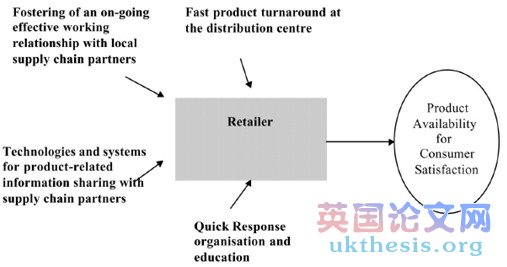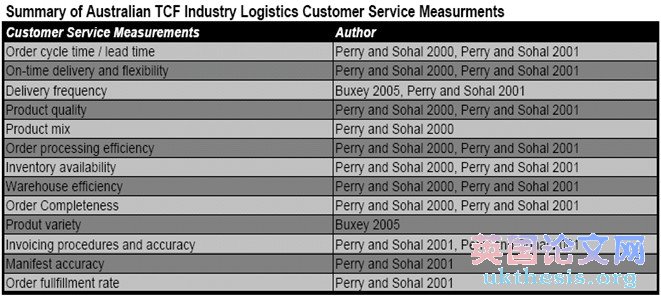澳大利亚理工大学dissertation例文:澳大利亚TCF行业快速应对策略和客户服务测量

Australian TCF industry Quick Response strategy and customer service measurements
澳大利亚TCF行业快速应对策略和客户服务测量
Australia's Textile, Clothing and Footwear (TCF) industries have experienced a major contraction over the past decade, with changes of government policy from the protectionist regime and increased international competition both domestically and overseas. According to a report on Victoria’s TCF industry, many organizations in the industry feel vulnerable, the loss of local customers and suppliers, and the negative impact that recent closures have had on industry confidence were frequently commented on. Organizations in the industry are now generally small, privately owned and they resist to shared provision of services, marketing and manufacturing capability with customers. The level of research and development and innovation in technology, systems or new products is low. To survive in the constantly evolving market, some organizations took actions to adapt their operations to new changes.
在过去的十年里,澳大利亚纺织,服装和鞋类(TCF)产业经历了一次大的收缩,从保护主义制度与政府政策的变化,并在国内及海外日益增长的国际竞争。据维多利亚的TCF行业的一份报告,许多组织在同行业中感觉到自己的脆弱,当地的客户和供应商的损失,带来的负面影响,最近关闭了行业信心经常评论。在同行业中的组织现在普遍较小,私人拥有和他们抵制共享提供与客户服务,市场营销和生产制造能力。系统或新产品研发和技术创新的水平低。为了生存,在不断变化的市场,一些机构采取行动调整其业务,以适应新的变化。
Basically, there were three major ways modifying business strategies. They are (1) Reorganizing supply chain. Some organizations source offshore to reduce cost and maintain profit; (2) Re-asserting power in market by re-emphasizing brand development and design; (3) Restructuring production system to cut production costs (Webber and Weller 2001). A leading TCF producer’s managing director also pointed out that organizations with a clear competitive advantage will survive. The business will revolve around areas where it adds greater value, such as brand management, customer focus, design, and supply chain management (Gettler 1999). Buxey (2005)’s study discovers strategies the survivors (actually) employ in adapting to the pressures of globalization. More than 30 companies ranging from small family businesses to subsidiaries of big multinationals were involved in the study. It was found successful organizations focus on quality and customer service, developing technologically advanced products. They preferred niche markets, or specific customer groups. At the same time, the industry structure has changed. The organizational power has extended from the lead firms at the top downwards over the manufacturers (Webber and Weller 2001, p.23). The retailer sector which is nearest to the consumers leads the chain of supply. They face more intense competition.#p#分页标题#e#
基本上,有三种主要方式,调整业务策略。它们是(1)重组供应链。有些组织来源海外,以降低成本和保持利润;(2)重新主张权力再次强调品牌的开发和设计市场;(3)重组生产系统,以降低生产成本(2001年韦伯和Weller)。
On the other hand, high level of market uncertainty is one characteristics of Australian TCF industry because of the nature of seasonal, fashion products. Quick response programs, just-in-time inventory systems, efficient consumer response and other similar philosophies have been applied in order to cope with the market uncertainty (Mattila et al. 2002). Australian government has funded similar programs since the early of 1990s to assist the Australian TCF industry improve its standards towards becoming more internationally competitive in global market. These programs include Quick Response (QR) Program, Supply Chain Partnerships Program and Value Chain Partnerships (Commonwealth of Australia 2000). These programs are followed, observed and analyzed (Sohal, Perry, and Pratt 1998; Perry and Sohal 2000; McMichael, Mackay, and Altmann 2000; Perry and Sohal 2001). It’s found that both retailers and suppliers are positively affected by the adoption of QR, and may strengthen their relative competitive positions. Trust and cooperation between retailers and manufacturers increased using QR. Pipeline acceleration also occurs as a direct result of QR adoption. Another notable finding is retailers are taking the opportunity to shift their holding and distribution costs onto the supply chain to both manufacturers and suppliers.
另一方面,市场的不确定性水平高是澳洲TCF行业的特征之一,因为季节性,时尚产品的性质。为了应对市场的不确定性(马蒂拉等。快速反应方案,刚刚在库存系统,高效消费者响应和其他相似的理念已应用于2002年)
http://ukthesis.org/dissertation_sample
QR is defined as a consumer driven business strategy of cooperative planning by supply chain partners, to ensure the right goods, are in the right place, at the right time, using IT and flexible manufacturing to eliminate inefficiencies from the entire supply chain. It aims to keep inventories as low as possible, while ensuring that goods do not run out on retailer shelves (McMichael et al. 2000, p.613). Retailers are the prime initiators of QR. Quick service, minimum stock levels, and fewer stock outs are emphasized by retailers (Buxey 2005). Manufacturers and suppliers had to modify their business practices and adopt QR to satisfy the retailers' requirements. From retailers’ perspective, the success of QR supply chain effort depends on the ability to keep product availability for consumer satisfaction while maintaining low level inventories and fewer retail markdowns (Perry and Sohal 2000). Figure 4 displays essential practices vital for retailer to satisfy consumers.#p#分页标题#e#
Figure : Retailer Quick Response Practices
图:零售商快速响应常规

It could be concluded from Figure 4 that majority practice are related with supply chain partners. Retailers expect supply chain partners to assist them to achieve on-time, in-full deliveries of products, fast product turnaround at the distribution centre. They are also looking for fostering on-going effective working relationship with partners, building technologies and system for product-related information sharing with partners. As the most important supply chain partner to retailers, manufacturers and suppliers should provide customer services which meet retailers expectation so that high level customer satisfaction could be achieved. Customer service measurements should associate appropriately with retailer expectations. The following measurements are adopted by several organizations which practice QR successfully (Perry and Sohal 2000; Perry and Sohal 2001; Buxey 2005).
Table : Summary of Australian TCF Industry Logistics Customer Service Measurements
表:澳大利亚TCF工业物流客户服务测量

It should be emphasized again that there is no universal list of measurements available (Emerson and Grimm 1996). Although manufacturers and suppliers in Australian TCF industry share the same industry characteristics, customer needs and expectations vary from organization to organization. It implies customer service measurements adopted by manufacturers and suppliers should base on the nature of product and segmented customer needs.
应该再次强调,不存在普遍的测量列表(爱默生和格林1996年)。虽然制造商和供应商TCF行业在澳大利亚的份额相同的行业特点,客户的需求和期望,因组织而异。这意味着通过制造商和供应商的客户服务测量应立足于产品和细分客户需求的性质。
